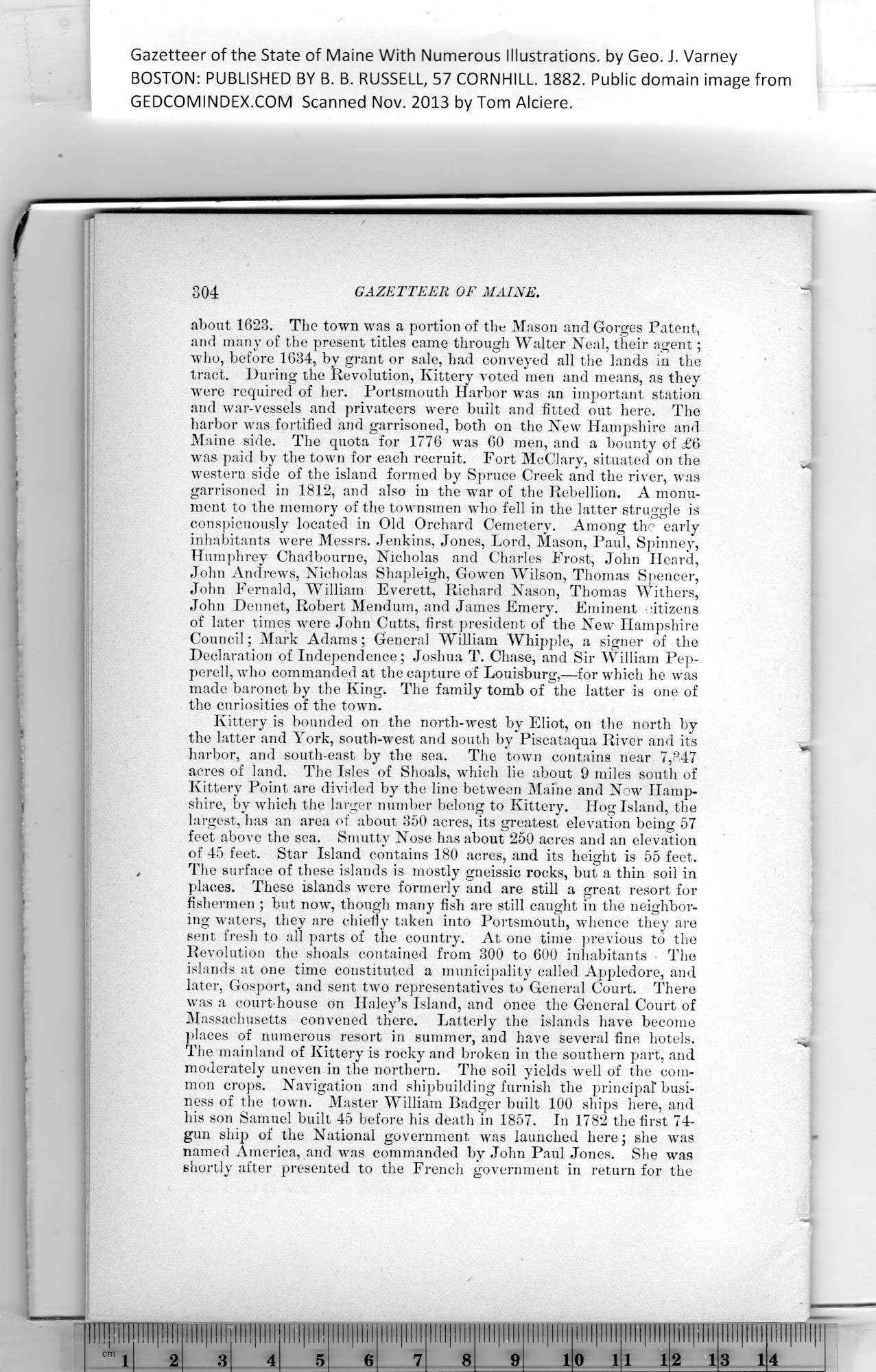|
Gazetteer of the State of Maine With Numerous Illustrations, by Geo. J. Varney
BOSTON: PUBLISHED BY B. B. RUSSELL, 57 CORNHILL. 1882. Public domain image from
GAZETTEER OF MAINE.
ahout 1623. The town was a portion of the Mason and Gorges Patent,
and many of the present titles came through Walter Neal, their agent;
who, before 1634, by grant or sale, had conveyed all the lands in the
tract. During the Revolution, Kittery voted men and means, as they
were required of her. Portsmouth Harbor was an important station
and war-vessels and privateers were built and fitted out here. The
harbor was fortified and garrisoned, both on the New Hampshire and
Maine side. The quota for 1776 was 60 men, and a bounty of £6
was paid by the town for each recruit. Fort McClary, situated on the
western side of tbe island formed by Spruce Creek and the river, was
garrisoned in 1812, and also in the war of the Rebellion. A monu-
ment to tbe memory of the townsmen who fell in the latter struggle is
conspicuously located in Old Orchard Cemetery. Among the early
inhabitants were Messrs. Jenkins, Jones, Lord, Mason, Paul, Spinney,
Humphrey Chadbourne, Nicholas and Charles Frost, John Heard,
John Andrews, Nicholas Shapleigh, Gowen Wilson, Thomas Spencer,
John Fernald, William Everett, Richard Nason, Thomas Withers,
John Dennet, Robert Mendum, and James Emery. Eminent viitizens
of later times were John Cutts, first president of the New Hampshire
Council; Mark Adams; General William Whipple, a signer of the
Declaration of Independence; Joshua T. Chase, and Sir William Pep-
perell, who commanded at the capture of Louisburg,—for which he was
made baronet by the King. The family tomb of the latter is one of
the curiosities of the town.
Kittery is bounded on tbe north-west by Eliot, on the north by
the latter and York, south-west and south by Piscataqua River and its
harbor, and south-east by the sea. The town contains near 7,347
acres of land. The Isles of Shoals, which lie about 9 miles south of
Kittery Point are divided by the line between Maine and New Hamp-
shire, by which the larger number belong to Kittery. Hog Island, the
largest, has an area of about 350 acres, its greatest elevation being 57
feet above the sea. Smutty Nose has about 250 acres and an elevation
of 45 feet. Star Island contains 180 acres, and its height is 55 feet.
The surface of these islands is mostly gneissic rocks, but a thin soil in
places. These islands were formerly and are still a great resort for
fishermen ; hut now, though many fish are still caught in the neighbor-
ing waters, they are chiefiy taken into Portsmouth, whence they are
sent fresh to all parts of the country. At one time previous to the
Revolution the shoals contained from 300 to 600 inhabitants The
islands at one time constituted a municipality called Appledore, and
later, Gosport, and sent two representatives to General Court. There
was a courtdiouse on Haley’s Island, and once the General Court of
Massachusetts convened there. Latterly the islands have become
places of numerous resort in summer, and have several fine hotels.
The mainland of Kittery is rocky and broken in the southern part, and
moderately uneven in the northern. The soil yields well of the com-
mon crops. Navigation and shipbuilding furnish the principal busi-
ness of the town. Master William Badger built 100 ships here, and
his son Samuel built 45 before his death in 1857. In 1782 the first 74-
gun ship of the National government was launched here; she was
named America, and was commanded by John Paul Jones. She was
shortly after presented to the French government in return for the
PREVIOUS PAGE ... NEXT PAGE
This page was written in HTML using a program written in Python 3.2
|
